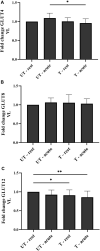Dynamics of training and acute exercise-induced shifts in muscular glucose transporter (GLUT) 4, 8, and 12 expression in locomotion versus posture muscles in healthy horses
- PMID: 37654675
- PMCID: PMC10466803
- DOI: 10.3389/fphys.2023.1256217
Dynamics of training and acute exercise-induced shifts in muscular glucose transporter (GLUT) 4, 8, and 12 expression in locomotion versus posture muscles in healthy horses
Abstract
Important changes in glucose transporter (GLUT) expression should be expected if the glucose influx plays a pivotal role in fuelling or connecting metabolic pathways that are upregulated in response to exercise. The aim was to assess GLUT4, 8, and 12 dynamics in response to training and acute exercise. Methods: Sixteen untrained Standardbred mares (3-4 year) performed an incremental SET at the start and end of 8 weeks harness training. M. pectoralis (PM) and M. vastus lateralis (VL) muscle biopsies were taken before and after each SET, allowing for comparing rest and acute samples in untrained (UT) and trained (T) condition using Western Blot for GLUT quantification and Image Pro v.10 for Blot analysis. Data were normalized against GAPDH. Basal GLUT-levels of PM versus VL were analysed with the Wilcoxon matched-pairs signed rank test. The effect of acute exercise or training was assessed using the Friedman test with a post hoc Dunn's. Results: Basal GLUT4 and GLUT12 protein expression were significantly higher in the VL compared to the PM (PGLUT4 = 0.031 and PGLUT12 = 0.002). Training had no effect on basal GLUT4 expression, neither in the VL (p > 0.9999), nor the PM (p > 0.9999). However, acute exercise in trained condition significantly decreased GLUT4 expression in the VL (p = 0.0148). Neither training nor acute exercise significantly changed total GLUT8 protein expression. Training significantly decreased total GLUT12 protein expression in rest biopsies, only visible in the VL (p = 0.0359). This decrease was even more prominent in the VL after acute exercise in trained condition (PVL = 0.0025). Conclusion: The important changes seen in GLUT12 expression downregulation, both in response to training and acute exercise in the horse, the downregulation of GLUT4 expression after acute exercise in trained condition and the lack of differential shifts in GLUT8 expression in any of the studied conditions, questions the importance of glucose as substrate to fuel training and exercise in healthy horses. These findings encourage to further explore alternative fuels for their involvement in equine muscular energetics.
Keywords: energy; equine; exercise; fuel; glucose; glycogen; metabolism; training.
Copyright © 2023 Vidal Moreno de Vega, Lemmens, de Meeûs d’Argenteuil, Boshuizen, de Maré, Leybaert, Goethals, de Oliveira, Hosotani, Deforce, Van Nieuwerburgh, Devisscher and Delesalle.
Conflict of interest statement
JO and GH were employed by the Cargill R&D Centre Europe. The remaining authors declare that the research was conducted in the absence of any commercial or financial relationships that could be construed as a potential conflict of interest.
Figures




References
-
- Arfuso F., Acri G., Piccione G., Sansotta C., Fazio F., Giudice E., et al. (2022a). Eye surface infrared thermography usefulness as a noninvasive method of measuring stress response in sheep during shearing: correlations with serum cortisol and rectal temperature values. Physiol. Behav. 250, 113781. 10.1016/j.physbeh.2022.113781 - DOI - PubMed
LinkOut - more resources
Full Text Sources
Research Materials

